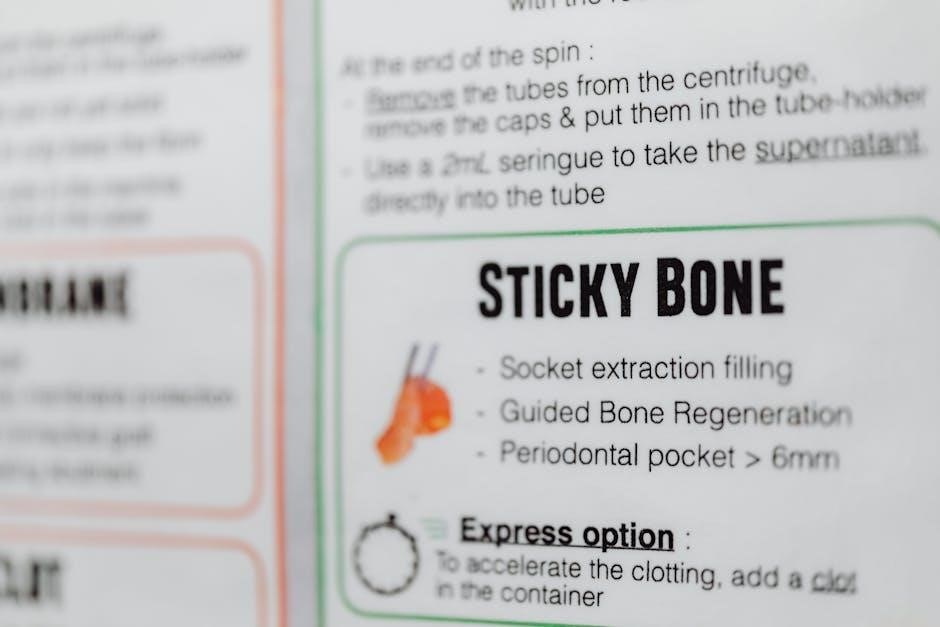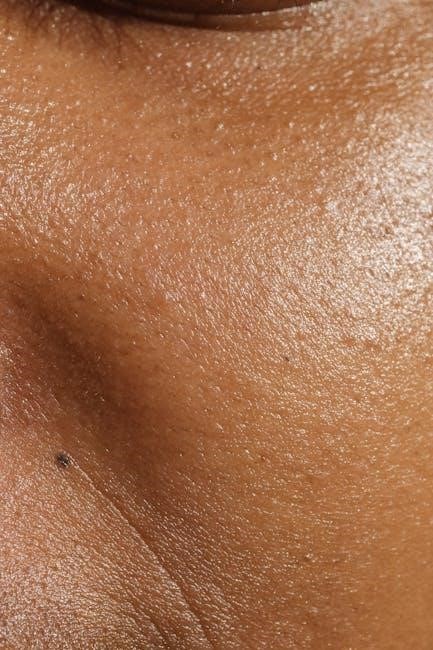Overview of Guided Tissue Regeneration (GTR)
Guided Tissue Regeneration (GTR) is a dental procedure that promotes the growth of new bone and gum tissue in areas damaged by periodontal disease or trauma.
1.1. Definition and Purpose of GTR
Guided Tissue Regeneration (GTR) is a dental procedure that uses barriers or membranes to direct the growth of specific cells, such as bone or gum tissue, into defective areas. Its primary purpose is to regenerate lost tissue caused by periodontal disease or trauma, restoring the natural structure of the mouth. By preventing unwanted cells from invading the defect, GTR promotes the growth of healthy tissue, enabling effective healing and improving oral function. This technique is particularly useful for treating bone defects and enhancing support for teeth or dental implants.
1.2. Applications in Dentistry
Guided Tissue Regeneration (GTR) has diverse applications in dentistry, primarily focusing on periodontal therapy and oral surgery. It is commonly used to treat periodontal defects, such as bone loss around teeth, and to enhance bone density for dental implant placement. GTR also aids in repairing tissue damage from trauma or infection, promoting healing and restoring function. Additionally, it supports aesthetic and reconstructive procedures, ensuring a more natural appearance and improved dental health outcomes. Its versatility makes it a valuable tool in modern dental care, addressing both functional and cosmetic needs effectively.
1.3. Benefits of GTR in Tissue Repair
Guided Tissue Regeneration (GTR) offers numerous benefits in tissue repair, primarily through its ability to regenerate lost bone and gum tissue. It prevents tooth loss by stabilizing teeth in affected areas and enhances overall oral health. GTR promotes natural tissue growth, reducing the need for synthetic materials. This procedure also improves aesthetics by restoring the natural contour of the gums and supporting facial structure. Additionally, it minimizes the risk of further tissue deterioration and supports successful dental implant placement. Patients often experience faster healing and reduced complications, making GTR a highly effective and reliable treatment option.

Understanding the Cost of GTR
GTR costs vary widely, influenced by factors such as geographical location and procedure complexity. A detailed breakdown helps understand the financial aspects of treatment.
2.1. Average Cost Range for GTR Procedures
The average cost for GTR procedures typically ranges between $500 to $2,500 per site, depending on the complexity and extent of tissue damage. Factors such as the size of the defect, materials used, and the surgeon’s expertise can significantly influence the price. In some cases, costs may exceed $3,000 for multiple sites or advanced techniques. Compared to other dental regeneration methods, GTR can be more affordable, especially for patients seeking long-term tissue repair. Insurance coverage varies, but some plans may partially reimburse the cost, making it a viable option for many patients seeking effective tissue regeneration.
2.2. Factors Influencing the Cost of GTR
The cost of GTR is influenced by several factors, including the complexity of the procedure, the materials used, and the location of the treatment. Resorbable membranes, often used in GTR, can be more expensive than non-resorbable alternatives. Additionally, the surgeon’s expertise and the clinic’s reputation may increase costs. Follow-up care and post-operative maintenance also contribute to the overall expense. Urban areas tend to have higher prices compared to rural regions. Insurance coverage and individual patient needs further impact the final cost, making it essential to consult with a specialist for a personalized estimate.
2;3. Comparison with Other Dental Regeneration Techniques
GTR stands out among dental regeneration techniques for its ability to target specific tissue types, often resulting in higher success rates for bone and gum repair. Compared to bone grafting, GTR can be more cost-effective for localized defects. However, procedures like dental implants may have higher upfront costs but offer long-term durability. Other techniques, such as enamel matrix derivative applications, are less invasive but may not provide the same level of tissue regeneration. Each method has its advantages, and the choice depends on the patient’s specific needs and budget, making GTR a viable option for certain cases.
Detailed Cost Breakdown
GTR costs include surgical fees, materials like barriers and grafts, and follow-up care. Prices vary based on procedure complexity, location, and patient-specific requirements.
3;1. Surgical Costs
Surgical costs for GTR procedures vary based on the complexity of the case, the surgeon’s expertise, and the location. On average, surgical fees range between $500 to $2,000 per site, depending on whether bone or gum tissue regeneration is required. Advanced techniques, such as minimally invasive surgery, may increase costs. These fees typically cover the procedure itself, including the surgeon’s time and operating room expenses. In some cases, additional charges may apply for anesthesia or specialized equipment. Surgical costs are a significant portion of the overall GTR expense, making them a key consideration for patients.
3.2. Material and Equipment Costs
Material and equipment costs in GTR include biocompatible membranes, bone grafts, and barrier materials. Membranes, which prevent unwanted tissue growth, can range from $100 to $500. Bone grafts, derived from human, synthetic, or animal sources, vary in price depending on the type and quality, costing between $200 to $1,000. Resorbable materials, which dissolve over time, are often more expensive. Additionally, specialized surgical instruments and equipment, such as 3D-printed grafts or advanced imaging tools, may add to the expense. These costs are essential for ensuring the procedure’s success and longevity, contributing significantly to the overall expense.
3.3. Follow-Up and Maintenance Costs
Follow-up and maintenance costs after GTR include post-operative care, suture removal, and monitoring of tissue healing. These costs typically range from $100 to $300, depending on the frequency and duration of follow-ups. Additional treatments, such as antibacterial therapy or gum care, may add to the expense. Regular check-ups ensure the regenerated tissue remains healthy and functional. These costs contribute to the overall investment in GTR, emphasizing the importance of long-term care for successful outcomes and preventing future complications.

Insurance Coverage and Financing Options
Insurance coverage for GTR varies, with some policies covering partial costs. Financing options, like payment plans or dental loans, help make the procedure more affordable for patients.
4.1. Does Insurance Cover GTR Procedures?
Insurance coverage for GTR procedures varies depending on the policy and provider. Some plans may cover a portion of the costs, especially if the procedure is deemed medically necessary. However, many dental insurances classify GTR as a cosmetic or elective procedure, which may not be covered. Patients should review their insurance policies and consult with their provider to determine the extent of coverage. Additionally, some clinics offer financing options or payment plans to help manage out-of-pocket expenses for uncovered portions of the treatment.
4.2. Financing Options for GTR
Financing options for GTR procedures are available to help patients manage costs. Many dental clinics offer payment plans or third-party financing through providers like CareCredit or LendingClub. Credit cards with low interest rates or promotional periods can also be used. Some practices provide in-house financing options tailored to patient needs. Additionally, patients may explore dental loans with flexible repayment terms. It’s essential to discuss financing details with the clinic or a financial advisor to find a plan that suits individual circumstances and budget constraints.
4.3. Payment Plans and Dental Loans
Payment plans and dental loans are popular options for managing GTR costs. Many clinics offer structured payment plans, allowing patients to pay in installments over time. Dental loans, often provided by third-party lenders, can cover procedure expenses with flexible repayment terms. These options help patients avoid upfront costs and manage financial strain. Interest rates and terms vary, so it’s important to review and compare options. Consulting with the dental team or a financial advisor can help identify the most suitable plan tailored to individual needs and budget constraints.

Cost-Effectiveness of GTR
Guided Tissue Regeneration (GTR) is cost-effective due to its long-term benefits, reducing the need for future treatments and providing a valuable investment in oral health.
5.1. Long-Term Benefits of GTR
Guided Tissue Regeneration (GTR) offers significant long-term benefits, including the restoration of functional bone and gum tissue, enhancing dental stability, and improving overall oral health. These outcomes reduce the need for future corrective procedures, making GTR a cost-effective solution. Patients often experience improved chewing function and aesthetics, boosting confidence. Additionally, successful GTR can prevent further tissue loss, thereby avoiding more invasive and costly treatments down the line. This makes it a valuable investment for patients seeking durable and lasting results in periodontal care.
5.2. Cost Comparison with Dental Implants
Guided Tissue Regeneration (GTR) often proves more cost-effective than dental implants, especially for patients requiring multiple procedures. While implants can range from $1,000 to $5,000 per tooth, GTR typically costs between $500 and $2,000 per site, depending on complexity. GTR is particularly advantageous for restoring bone and gum tissue, potentially avoiding the need for implants altogether. However, for severe cases requiring both tissue regeneration and implants, combined costs can escalate. GTR’s ability to preserve natural structures often makes it a more economical and less invasive option in the long run.
5.3. Value for Money in Tissue Regeneration
Guided Tissue Regeneration (GTR) offers significant value for money by promoting natural tissue growth and preserving dental structures. While initial costs may seem high, GTR often reduces the need for more expensive procedures like dental implants. Patients benefit from long-term savings through reduced maintenance and fewer future interventions. The procedure’s ability to regenerate bone and gum tissue provides a durable solution, making it a cost-effective option for sustainable oral health. Overall, GTR balances immediate investment with lasting benefits, ensuring a high return on investment for patients seeking reliable tissue regeneration.
Geographic Variation in GTR Costs
GTR costs vary significantly by location, with differences in regional pricing, availability of specialists, and local regulations influencing treatment expenses and patient accessibility.
6.1. Cost Differences Across Countries
GTR costs vary significantly across countries due to differences in healthcare systems, dentist expertise, and material prices. In developed nations like the USA and Germany, procedures are often more expensive due to high labor costs and advanced facilities. In contrast, countries with lower labor costs, such as India and Mexico, offer more affordable options, making them popular for dental tourism. Additionally, local regulations and insurance coverage play a role in pricing disparities, affecting overall accessibility for patients worldwide.
6.2. Urban vs. Rural Cost Variations
GTR costs differ between urban and rural areas, primarily due to variations in dentist expertise, facility costs, and demand. Urban centers typically have higher prices because of specialized clinics, advanced equipment, and higher overhead expenses. Rural areas often offer more affordable options due to lower operational costs, though access to skilled specialists may be limited. Additionally, urban regions may have more competitive pricing dynamics, while rural areas might see fewer providers, leading to less flexibility in cost. This disparity can influence patients’ decisions on where to seek treatment, balancing cost and quality of care.
6.3. Impact of Local Regulations on Pricing
Local regulations significantly influence GTR pricing by shaping healthcare standards, licensing requirements, and medical practice protocols. Stricter regulations may increase costs due to compliance expenses, such as facility accreditation and specialist certifications. Additionally, regions with stringent material approval processes may limit the use of certain biomaterials, affecting procedure availability and cost. Conversely, areas with more relaxed regulations might offer lower-priced GTR procedures, though this could compromise quality and safety. These regulatory variations create a balance between cost, compliance, and patient outcomes, making it essential for patients to consider both affordability and adherence to medical standards when choosing a treatment location.

Advanced Techniques in GTR
Advanced GTR incorporates biomaterials, growth factors, and modern surgical tools to enhance tissue regeneration, offering precise and efficient outcomes with reduced recovery times and improved results.
7.1. Use of Biomaterials in GTR
Biomaterials play a crucial role in GTR, serving as scaffolds to guide tissue growth. Commonly used materials include collagen membranes, synthetic polymers, and bioactive glasses. These materials are biocompatible, promoting cell attachment and differentiation while preventing unwanted tissue infiltration. Advanced biomaterials, such as nanostructured surfaces and growth factor-impregnated membranes, enhance regeneration efficiency. The choice of material influences procedure costs, with synthetic options often being more affordable than biologic ones. High-quality biomaterials may increase initial expenses but offer long-term benefits through improved healing and reduced complications.
7.2. Role of Growth Factors in Tissue Regeneration
Growth factors, such as platelet-derived growth factor (PDGF) and bone morphogenetic proteins (BMPs), are essential in GTR for stimulating cellular processes. They enhance proliferation, differentiation, and migration of osteoblasts and fibroblasts, accelerating tissue repair. These biologic agents are often combined with biomaterials to create an optimal environment for regeneration. While highly effective, growth factors significantly increase treatment costs due to their complex production and limited availability. Their incorporation into GTR procedures can elevate the overall expense, but they offer substantial benefits in terms of healing predictability and tissue quality, making them a valuable investment for long-term outcomes.
7.3. Modern Surgical Instruments and Their Costs
Modern surgical instruments play a critical role in GTR, enabling precise tissue manipulation and minimizing trauma. Advanced tools, such as microsurgical instruments and laser systems, are often required to ensure optimal outcomes. These instruments are typically costly due to their specialized design and technology. The expense can vary significantly depending on the brand, quality, and complexity of the equipment. While these tools increase the upfront cost of GTR procedures, they contribute to higher success rates and reduced recovery times, making them a valuable investment in achieving long-term tissue regeneration goals.
Success Rate and Cost Implications
Guided Tissue Regeneration (GTR) has a high success rate, with costs reflecting the complexity and precision required to achieve optimal tissue regeneration and lasting clinical outcomes.
8.1. Factors Affecting GTR Success Rates
The success of Guided Tissue Regeneration (GTR) is influenced by patient health, defect severity, and compliance with post-operative care. The quality of materials used, such as barriers and grafts, also plays a role. Surgical expertise and technique significantly impact outcomes, as does the patient’s lifestyle, including smoking habits. Genetic predispositions and the presence of systemic diseases, like diabetes, can further affect healing. These factors collectively determine the likelihood of achieving optimal tissue regeneration and long-term stability.
8.2. Cost Implications of Failed Procedures
Failed GTR procedures can lead to additional financial burdens for patients. The cost of repeat surgeries, new materials, and extended recovery time significantly increases the overall expense. Patients may incur fees for diagnostic assessments to determine the cause of failure. Furthermore, the need for alternative treatments, such as dental implants, adds to the cumulative cost. These factors highlight the importance of initial procedure success to minimize long-term financial and emotional stress for patients seeking tissue regeneration solutions.
8.3. Cost of Revision Procedures
Revision procedures following a failed GTR can incur significant costs, often exceeding the initial treatment due to the complexity of corrective measures. Patients may face additional expenses for new surgical interventions, specialized materials, and extended post-operative care. The cost of revision procedures typically ranges between $500 and $2,500, depending on the extent of the failure and the techniques required to address it. These costs highlight the importance of achieving success in the initial procedure to avoid further financial and emotional strain for patients undergoing tissue regeneration therapies.

Patient-Specific Cost Considerations
Costs vary based on patient age, health conditions, and treatment requirements, with older patients or those with pre-existing conditions often needing more complex, expensive interventions.
9.1. Cost Variation Based on Patient Age
The cost of guided tissue regeneration (GTR) varies significantly based on patient age. Older patients often require more complex procedures due to advanced bone loss or gum recession, increasing expenses. Younger patients typically have healthier tissue, leading to simpler and less costly interventions. Factors such as the extent of tissue damage, overall health, and the need for additional treatments also influence age-related cost differences. These variables necessitate personalized treatment plans, further affecting the final price. As a result, age plays a crucial role in determining the overall financial investment for GTR procedures.
9.2. Impact of Pre-Existing Conditions on Cost
Pre-existing medical conditions significantly influence the cost of guided tissue regeneration (GTR). Patients with diabetes or immune disorders may require additional treatments to ensure proper healing, increasing expenses. Conditions like gum disease or bone loss also necessitate more extensive procedures, leading to higher costs. Furthermore, patients with a history of smoking or poor oral health may need supplementary interventions, further elevating the financial burden. These factors require tailored treatment approaches, making pre-existing conditions a key determinant in the overall cost of GTR procedures;
9.3. Customized Treatment Plans and Costs
Customized treatment plans for guided tissue regeneration (GTR) are tailored to address individual patient needs, influencing overall costs. Factors such as the extent of tissue damage, patient health, and specific dental requirements shape the plan. Advanced materials or complex surgical techniques may be necessary, increasing expenses. Additionally, the need for multiple procedures or specialized care can elevate costs. While personalized plans ensure optimal outcomes, they often result in higher financial investment compared to standard treatments. However, the long-term benefits of customized GTR justify the additional expense for many patients seeking durable and effective tissue repair solutions.

Emerging Trends in GTR
Emerging trends in GTR include advancements in biotechnology, such as innovative biomaterials and growth factors, which are paving the way for cost-effective and highly efficient tissue regeneration techniques.
10.1. Advances in Biotechnology and Cost Reduction
Recent advancements in biotechnology have significantly impacted GTR by introducing cost-effective solutions. Innovations in bioactive materials and growth factors reduce reliance on traditional, expensive methods. These developments enhance tissue regeneration efficiency while lowering overall costs. Biodegradable scaffolds and recombinant growth factors are examples of such innovations, offering sustainable and affordable options for patients. As biotechnology progresses, the integration of these cutting-edge materials into GTR procedures is expected to further reduce costs, making the treatment more accessible. This shift underscores the potential for biotechnology to revolutionize dental tissue regeneration.
10.2. Future of GTR and Cost Projections
The future of GTR is promising, with advancements in biotechnology and regenerative medicine expected to enhance outcomes while reducing costs. Emerging technologies, such as 3D printing and stem cell therapy, may improve procedure efficiency and lower material expenses. Cost projections suggest that as these innovations become mainstream, GTR could become more affordable, making it accessible to a broader patient population. Additionally, increased competition and improved manufacturing processes may further drive down prices, ensuring that GTR remains a viable and cost-effective option for dental tissue regeneration in the coming years.
10.3. Potential Impact of Research on Pricing
Research advancements in GTR could significantly influence pricing by reducing costs through improved efficiency and material development. Innovations in biotechnology and regenerative medicine may lower production expenses for biomaterials and growth factors. Additionally, streamlined surgical techniques could minimize operation time and resource use, further decreasing costs. However, the integration of cutting-edge technologies may initially increase prices due to development and implementation expenses. Government and institutional funding for research could also mitigate costs, making GTR more affordable. Overall, ongoing research holds the potential to balance innovation with cost-effectiveness, ensuring GTR remains a viable option for patients.